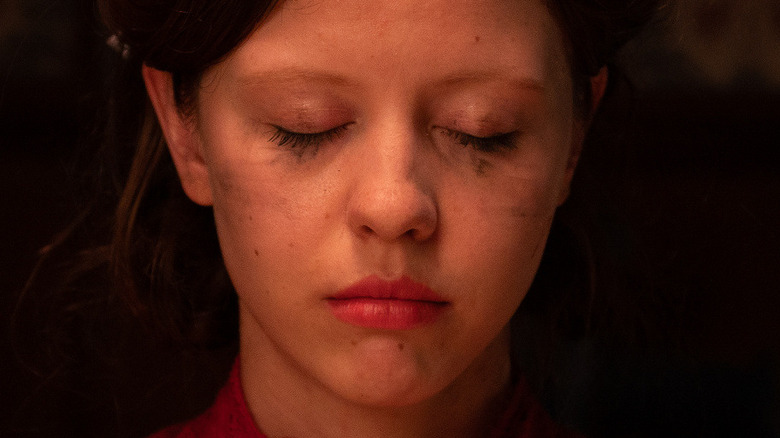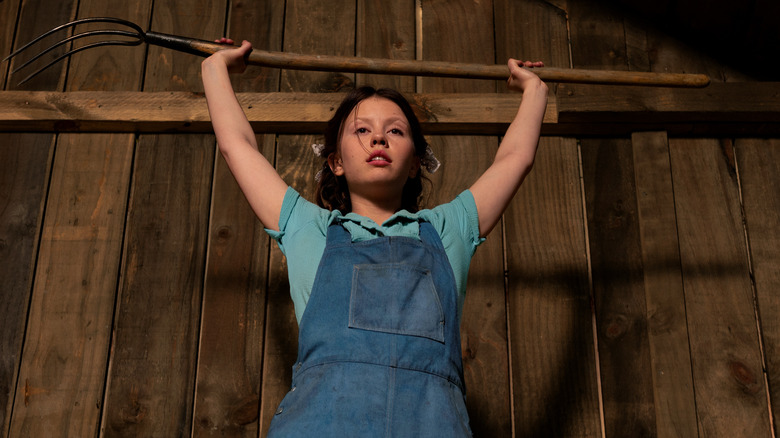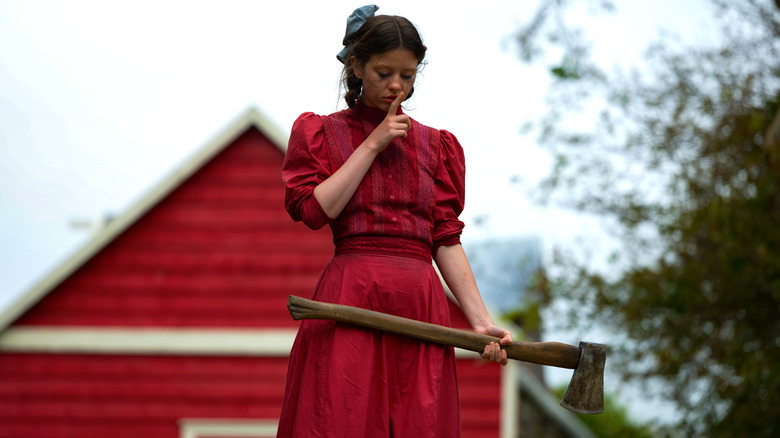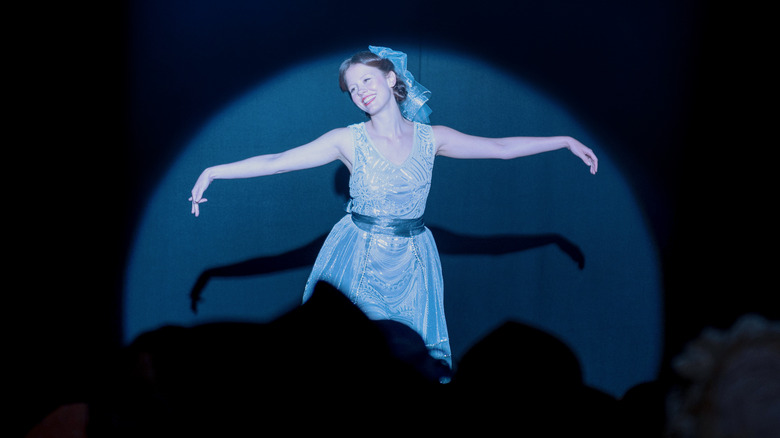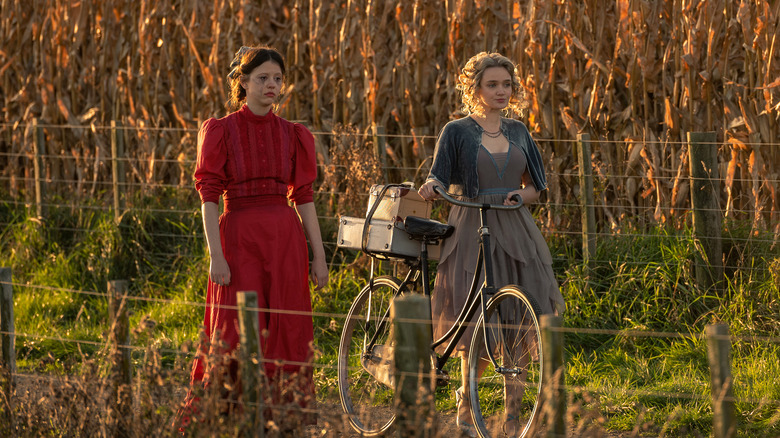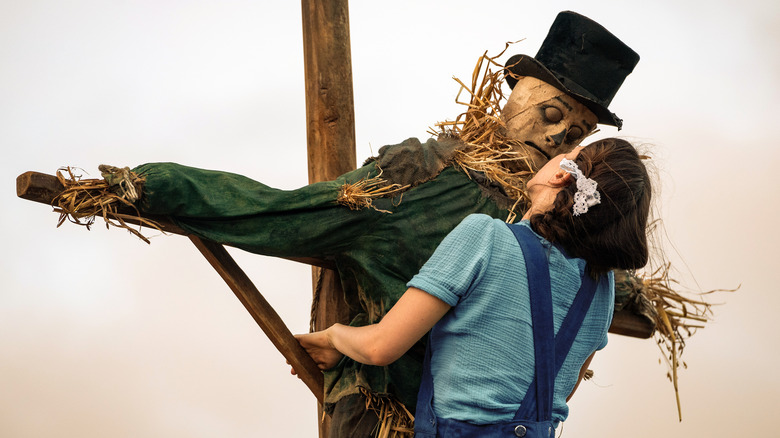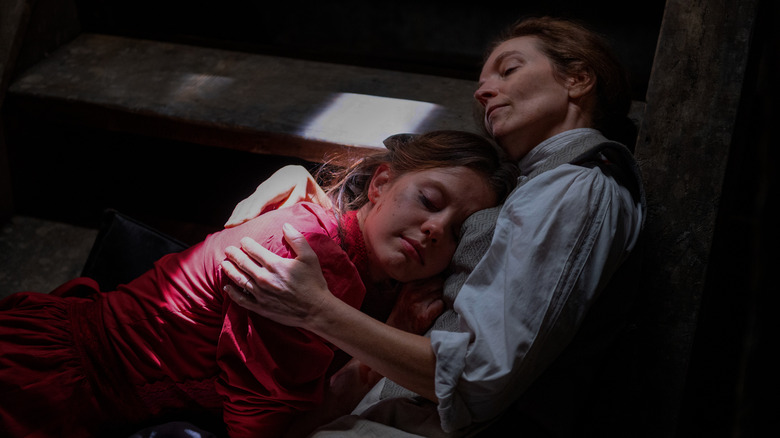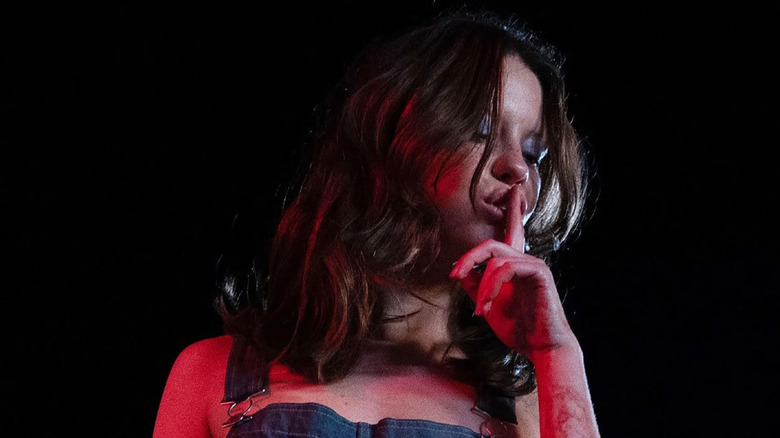Pearl Director Ti West On Shooting His Secret Prequel, 1918's Relevance To Today, And More - Exclusive Interview
March 2022 saw the release of "X," written and directed by indie horror auteur Ti West. A gritty homage to "The Texas Chain Saw Massacre" and other '70s genre fare, the film follows a small group of actors and filmmakers who set out to make an adult film in the guest house of a decrepit Texas farm. The elderly owners, Howard and Pearl, are not on board with this at all, and soon a series of gruesome murders commences.
In an astonishing dual role, British actress Mia Goth played both aspiring porn actress Maxine Minx and, with the help of prosthetics, the unnerving Pearl, who once harbored her own dreams of fame and is now bitterly resentful of both her lot in life and the sexy young Maxine. "X" was acclaimed as a smart take on the '70s slasher movie, the adult film industry, and the craft of filmmaking itself.
Shortly after the release of "X," it was announced that a prequel, "Pearl," starring Goth (who co-wrote the script with West) as a younger version of the character, was secretly filmed just three weeks after "X," utilizing the same New Zealand farm on which the first movie was shot. In the film, Pearl descends into madness and violence as she tries to break free from the farm and her overbearing mother (Tandi Wright).
Unlike the intentionally grainy "X," "Pearl" is set in 1918 and makes use of a vibrant, Technicolor-inspired palette reminiscent of films like "The Wizard of Oz" or "All That Heaven Allows." by Douglas Sirk. "I felt like, 'Fantasy, Technicolor-inspired movie,' let me let you think what it is," West tells Looper, "and then hopefully give you something different." Coming next from West: "MaXXXine," starring Goth once again as Maxine Minx as she navigates the adult film world of the 1980s.
Ti West set out to make one movie and ended up making two
You were in quarantine in New Zealand, waiting to start shooting "X," and you started getting the idea for "Pearl," right?
At the time we were making "X," it was peak COVID, and we were fortunate enough to be going to New Zealand, which was a safe place to make a movie. We had spent a lot of effort getting a really tremendous crew, getting visas for everybody. We built a barn, we built a bunkhouse, we were putting a lot of effort into the infrastructure to make this movie "X." To me, when the future was so uncertain of whether we would ever be able to make a movie again, it was like, "We're fortunate enough to be here. What if we made two movies?" Then it was like, "How would such a thing happen? How would that make sense?"
I started to think that it'd be a waste to get rid of everything that we're building down here. Is there anything else we could do with it? I didn't think there was, because I thought a sequel to "X" didn't really seem that appealing, where more people go to a farm and get killed. There wasn't a movie there.
I had cast Mia Goth as Pearl and Maxine and we had been spending a lot of time talking about Pearl and her backstory. In "X," you don't really get to know a lot about Pearl's backstory because she's the villain in the movie and you don't have that insight other than the basic emotional aspect of it. We had been coming up with what her story was, and then it occurred to me that [there's] a way to cannibalize everything that we have here and take the villain from the one movie and make her the star of another movie.
The idea started forming from there. In those two weeks of mandatory quarantine to get into the country, I would FaceTime with [Goth] because she was still in New York and we would collaborate on an idea and we'd cranked out a script in two weeks.
The studio was behind West's instant double feature
Was it easy to get the studio on board with the idea of making two movies?
I showed it to A24 and they were very intrigued and excited about it, but they weren't ready to commit. I worked on it a little bit more, we got "X" up and running, and everyone was feeling good about everything. There came a point where it was like, "If we're going to do this, we should decide now, because then we can make 'X' better for it. We can put things in "X" and the connective tissues of the movie will be bigger. People who are working on "X" can get started on things, like trying to find Model T cars — stuff that's going to take a while to find.
Miraculously, to the credit of A24, they took a deep breath and they bet on it and before we shot even a frame of "X," they greenlit "Pearl." We were able to make the movies essentially like one big movie with — not a hiatus in between, because we were working — but we went back to prep for three weeks and then made two movies.
Mia got so invested in both these characters. She ended up co-writing "Pearl" with you. How was that collaboration?
Mia is amazing and we clicked right from the beginning and I knew that she's 110% committed to everything that she does. She was Pearl in "X," and ... to be working with her on "X" and knowing that there's a prequel, it felt like she should be involved from the conception of it because if she couldn't do it, it's not like I would have cast somebody else. There would have been no movie. She felt integral to the whole thing, so it made sense to start from the beginning and collaborate together on that.
West had another version of Pearl ready to go too
You initially had the idea of doing this as a black and white film. How did that evolve 180 degrees into this very vibrant, Technicolor-inspired style you ended up with?
The black and white idea, which stuck around for a little while in the very beginning, was going to be in this German Expressionist style, for lack of a better way to describe it, and it would have been interesting. A big part of the reason for that was that it would have been even faster and cheaper to make. Let's say a wall was blue, well, now if it's gray, it doesn't matter. We don't have to repaint it, we don't have to do anything and we don't have to spruce up the farm to feel brand-new. We don't want it to be as beat up as it is in "X," but it could be a little fix rather than completely turning the farm into a Technicolor set. That would be a major overhaul.
The black and white version was there to be faster, cheaper, and easier, plus there's an interesting aesthetic to it, to do something in this Gothic horror tradition. You could read the script and you could picture that movie and it would be an interesting movie. The other idea I had was this very vibrant, almost kid's film version of it, and that was more interesting, but it was more expensive, and more time-consuming, and harder. I wanted to have the other one as backup, because I was looking for every reason to help get this movie made.
Credit to A24, they probably would have done the black and white movie if I pushed it, but they weren't as excited about that. They were excited about this Technicolor-inspired version. The extra few bucks it cost for wallpaper and extra paint and things like that wasn't an issue. They were like, "It's the right thing to do for the movie," and they were correct. It was the better version of the movie, but I had in my back pocket that we could save $5 more if we did it this other way.
The cinema history behind the look of Pearl
Were there certain films or directors — people have mentioned Douglas Sirk and you've brought up "The Wizard of Oz" — that you looked at in terms of the look you wanted?
It was more like an era than a specific film or a specific director. "The Wizard of Oz," certainly with the Scarecrow and some of her bike riding, that was like with "X" and [the influence of "Texas Chain Saw Massacre"]. I was like, "I can't get away from this, because it's too baked into what it is, so we might as well just embrace it." Once you put people in a van in Texas and it's a slasher movie, I'm not going to pretend you don't think you know where it's going, so I'm going to let you think where it's going and then hopefully go somewhere else. I felt the same way about "Wizard of Oz." I felt like, "Fantasy, Technicolor-inspired movie, let me let you think what it is and then hopefully give you something different."
Anything else that was referential was much more for aesthetics. We might have looked at, say, "The Red Shoes" or something to think about color saturation and things like that. Not so much scenes and not so much story or movie as much as [thinking], "How red can we go with this compared to how blue we go with this? They used to use these lights to do this and it creates this look and since we don't have that equipment. How can we get that color?"
How Pearl is connected to The Wizard of Oz and a 100-year-old pandemic
What's the subtext with "The Wizard of Oz," if there is one?
It's hard for me to say. There's not an on-purpose one. The similarities to it are that it's someone who is living in a world that is not the one that they necessarily want to be in, and then they have an experience in a larger-than-life version of that world. That was within the DNA of what "Pearl" was, so there's a common thread there. It wasn't as if it was like, "Hey guys, let's all talk about 'Wizard of Oz'" or anything.
Once you get into a movie that's about a young girl from a farm and it's a Technicolor vibe, it's like the "Texas Chain Saw" thing ... Let's embrace it and let it be a movie where your expectations are sending you one way, because your expectations from cinema history are making you think this movie's going to go one way, then it goes another way.
It's also interesting that you set this during the Spanish flu pandemic. There has been some discussion about how movies are not acknowledging the world we've lived in for the past few years, but your movie acknowledges that — except 100 years ago.
We were all going through it to an extreme at the moment we were writing it, but when you subtracted the age from Pearl to get her back to an appropriate age for the movie, it landed right around 1918, which was its own miracle from a modern storytelling standpoint. It made sense — this is something that's going to be relatable to quite literally everyone on earth, and it was one of those strange things that aligned that made sense.
It was a movie about someone who felt isolated, so it lent itself to it perfectly. If we had made this movie five years ago, you'd see people wearing masks and being worried about getting sick, and you would have been like, "I remember there was a flu back then," but now it's, "I know what that's like."
The unusual way that Ti West cast Pearl's mother
How did the intimacy coordinator on "X," Tandi Wright, end up taking the role of Pearl's mother, Ruth, in this one?
I had been spending time with Tandi for six weeks when we were making "X" and she was delightful. She was also an actor and even though she was intimacy coordinator for us, I was aware that she had a background in acting. When we were thinking about casting Ruth in "Pearl," I said to her at lunch one day, "Tandi, we're going to make another movie, you should audition for this."
She was like, "I don't know." And I was like, "Well, worst case, you don't end up in the movie. We have a five-minute awkward conversation on Monday and then we get back to work and we're back laughing, having a good time. Best case, you nail it, and you're in the movie and wouldn't that be something?" She was like, "I don't know, I'll think about it."
On the weekend, she got Owen Campbell, who played RJ in "X," to film her and Martin Henderson, who played Wayne. He read opposite her, and Tandi did the whole five-page dinner table monologue scene for her character completely off-book in a German accent. She is not German, she is from New Zealand, and it was amazing.
I remember watching it over the weekend and showing it to the assistant director and him being like, "Whoa." On Monday, we called everyone at A24 and showed it to them, and everybody loved it. She was back on set on Tuesday, and I was like, "Guess what? You're in the movie." She was shocked by it, and then she had about three weeks to learn a lot of German.
It's really a fun story, because it's now part of the lore of the movie. Really, it's a testament to Tandi being a terrific actor.
MaXXXine will take the story into a new decade
Next is "MaXXXine." How's the aesthetic going to change again, because I imagine it is, and how does it take the story of Maxine forward?
I'm going to remain tight-lipped about it, because I was able to keep the whole movie of "Pearl" a secret for the whole time we made it, so it would take a lot of the fun out of it to start telling people about it. It takes place in 1985 and it takes place in Hollywood and it is a different aesthetic and a different perspective on how cinema is affecting the movie. It affects people in "X" differently than it does in "Pearl," and in "MaXXXine," it affects people differently than the other two.
Do you have the script? Have you started shooting?
I'm going to tell you that I know all these things and that eventually this movie will come out.
In both "Pearl" and "X," the main characters are women who yearn for stardom and yearn to be something beyond what they are. They're set in 1979 and 1918, but they're both completely relevant to today. Is that something you thought about while working on both of these movies?
I feel like the themes of wishing that you had a different life and perhaps looking to movies as an example of that is universally common. People can all relate to that. With "X" being the first one that I wrote and the first one we made, it was a movie about the craft of cinema and what it's like to make a movie. We wanted to take a modern audience and show them what it's like making a movie and hopefully charm them with that.
In telling these universally relatable stories about wishing your life was different and using cinema as a catalyst to that, it seemed like a compelling way in. In the same way that using the Spanish flu in "Pearl" could be about COVID without being about COVID, you could make a movie about moviemaking without it being so literal. "MaXXXine" is an extension of that.
"Pearl" is now playing in theaters.
